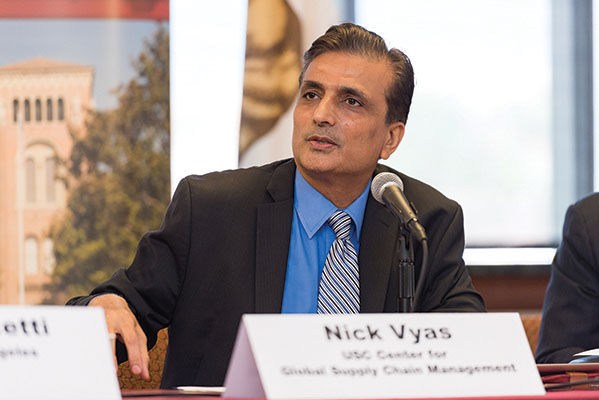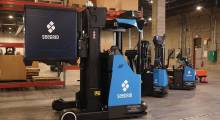Nick Vyas
Location: Los Angeles
Primary Focus: A former supply chain executive, Vyas is the executive director and co-founder of the University of Southern California’s Marshall Center for Global Supply Chain Management and assistant professor of clinical data sciences and operations.
Modern: One of the latest bright shiny objects in the supply chain is on-demand warehousing. What is it, and why is it important?
Vyas: On-demand warehousing is a game-changer for the supply chain. It isn’t a whole lot different than what Uber and Airbnb do in matching people to underutilized vehicles and lodging, respectively. It’s all about matching up companies with excess warehouse space with companies with short-term excess inventory. It’s a win-win. Those with the extra space can generate some revenue by leasing it out to those companies that don’t want to build their own facility or go to a long-term 3PL contract. And there’s plenty of excess warehouse space out there: The annual utilization rate nationally for warehouses is about 62%.
Modern: How far along in its development is on-demand warehousing?
Vyas: We’re definitely in the early days. But there’s already one huge player here: Fulfillment by Amazon. Some of Amazon’s Marketplace partners pay to have the e-commerce giant warehouse and distribute their inventory. That’s on-demand warehousing. Others fulfill orders on their own. But Amazon can’t build warehouses fast enough to keep up with the demand for the products it is selling. So new forms of on-demand warehousing are emerging.
Modern: Is Amazon the reason why this is emerging now, in 2018?
Vyas: Part of it is Amazon. Part of it is what has happened with Uber and Airbnb. We know the concept is a good one. Just as important is the development of next-generation supply chain technologies such as artificial intelligence that make it possible to build the online exchanges that will make on-demand warehousing possible and profitable. Overall, this is a paradigm shift.
Modern: Which raises the question, what will the impact be on 3PLs?
Vyas: On-demand warehousing will not disrupt 3PLs. It’s a different model. The people interested in placing their inventory in an on-demand warehouse aren’t looking for a five-year lease for many, many thousands of square feet. They need the flexibility to lease much less space for a relatively short period of time. The 3PL model can’t accommodate that. Then again, maybe 3PLs will change their model to accommodate on-demand warehousing. We’ll see.
Modern: Do you have a timeline in mind for the adoption of on-demand warehousing?
Vyas: Within five years it will be a fairly standard practice. Right now it’s a bit of a novelty, but not for long. Exchanges such as Warehouse Exchange will digitize the transaction between those with space and those with inventory. The importance of technology cannot be understated. There’s something else going on here, too. Just think if companies stopped building warehouses for peak periods. Instead, they right-sized them to match expected average annual utilization rates. When that happens on a broad scale, you have a new driver of on-demand warehousing for peak periods.
Modern: If you had to sum up what on-demand warehousing is all about, how would you put it?
Vyas: I’m a pure optimist about the future of this. On-demand warehousing has the potential to eliminate a lot of unwanted friction, which in the supply chain are underutilized assets, specifically warehouse space. That friction is, today, the largest single cost in the supply chain. So, here’s a great opportunity for many to improve their margins and profitability. On the other side, on-demand warehousing creates a level field for companies of all sizes. Even the smallest companies can take all the orders they can handle without worrying about having enough warehousing space to store the inventory to fill those orders. It’s now a matter of how quickly we can adopt, embrace and build out a new on-demand warehousing ecosystem.
Article topics









